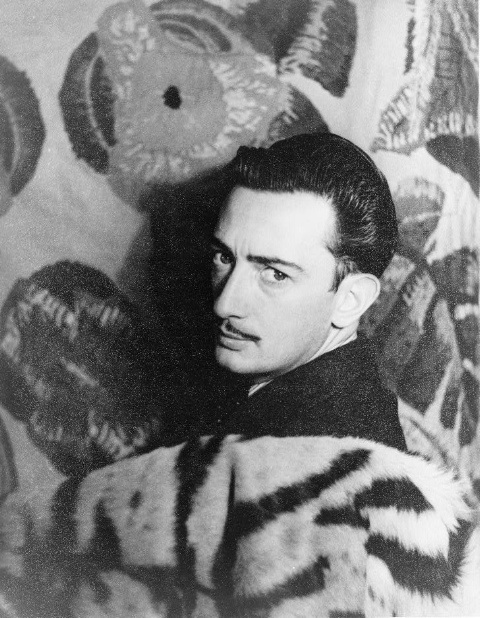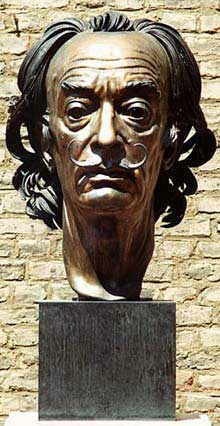Home
|
Prometheus Nr. 201|
Alexander
Order
Salvador
Dalí: Who is Dalí
The 120th
birthday of a Genius: Interview with an eyewitness
By B. John
Zavrel

From the toy-boy
of Gala
to the world-famous surrealistic painter:
Salvador
Dalí.
In 2014, the late artist is better known around the world than his
countryman Pablo
Picasso.
This artistic photograph of the smart young Spaniard was taken in
Paris.
Photograph: Wikipedia
Cadaques/New York (bpb) Admirers of
Salvador Dalí can celebrate his 110th birthday on May 11,
2014. On this occasion "Prometheus" did an interview with Joe F.
Bodenstein. He was for decades an Associated Press correspondent in
Germany, he personally knew the surrealist painter and is thus an
eyewitness himself. The interview was done by Consul B. John Zavrel.
He is the founder of the US-Museum of European Art (Meaus) in
Clarence, New York, and the honorary director of Foreign Affairs of
the non-profit organization "European Art Foundation Germany". In
this mission he supports the transatlantic cultural relations between
USA and Western Europe.
Question: We would
like to know from you--as an eyewitness: How was Dalí really ?
Answer: This question cannot be
answered in a definitive and total way. I am sure that Dalí
himself did not know, what and how he was. From my experience I can
only say: This Spanish painter had a great knowledge of historical
developments, of religion and of art history. On this basis he
developed his surrealistic visions for the future. We all could not
understand everything he did and follow what he meant. But everybody,
who become an art-loving follower of this personality had the great
feeling of being part of this emotional Dalí-World.
Question: Articles
during his lifetime and in the past reported that, the Spanish
painter was "funny, crazy" and "far away from a realistic
life".
Answer: The eccentric behavior was a
part of his marketing strategy. He liked the show, he liked to shock
people in different ways. He dressed up like a movie star, sometime
as "King of his own universe" or as a High Priest and a Prophet. This
was for the public. But as soon the crowds were gone, and he sat
together with a few people, he was quite calm and "talking in a
normal way".
Question: When did
this happen, and how often ?
Answer: I like to mention the
friendship among the painter Ernst Fuchs (Wien), the German-French
sculptor Arno Breker (1900-1991) and Salvador Dalí. He has
proclaimed in 1975: "We are the Golden Triangle in Art. Where we are
it is the top". These three artist-friends had great admiration for
one another. Salvador Dalí was the outstanding "divine
painter" (according to himself). Ernst Fuchs, son of a Jewish father
and an Austrian beauty, is the last "Maler-Fürst"
(Painter-Prince) in Europe, and Arno Breker is the leading sculptor
of the Classical tradition in Art of the 20th century. The artistic
achievements of these three giants were on the same high level.
Therefore, it was not so difficult for them to become friends. All of
them had their own collectors.
Question: What
made Dalí so famous in the history of art ?
Answer: I like to say: The basis of
his success was his unique ability to paint the things as he could
see them. Further: his whole life he had people by his side to push
him up and to support most of his ideas and actions. The young fellow
got a fundamental impulse from Gala, who later became his wife. One
of the best things what has happened was the cooperation with his
secretary, manager and real friend: Captain Peter Moore. It is said
he was an officer of the British Secret Service. But when I met him
as a journalist and as an art-collector, "the Capitano" (as
Dalí used to call him respectfully) was for me a trustful
gentleman. I was impressed how he and his intelligent wife Catherine
served the "maitre". But Dalí's wife and so-called muse Gala
was "not amused" by this close friendship. She became very jealous.
Question: How
could it happen that Gala got so much influence over Salvador
Dalí?
Answer: Let me remind you of an old
European saying: 'Love makes blind !' Born Elena Ivanovna Diakonova
in Russia, usually known as Gala, she was first the wife of Paul
Éluard, the French poet who was one of the founders of the
surrealist movement. On his journey to Spain with Gala she met
Dalí. He was ten years younger than her. In 1929 Eluard had
another bout of tuberculosis. He separated from Gala when she left
him for Salvador Dalí, with whom she remained for the rest of
her life. When their affair started, the painter was young, healthy,
sexy and already well off.
Question: And that
is all--how a woman can get influence over a man and an artist
?
Answer: No no ! Gala was not a
simple, ordinary person. She was an experienced, intellectual woman
with fine manners. . And she was ten years older than Dalí. In
the society of Paris it was not long a secret that Gala taught the 25
years young "sailor of Cadaques" how to make love. Until meeting with
Gala, the painter was a virgin, it is told. After falling in love
with Gala and their romances in the caves of the beach around
Cadaques, Dalí slowed down his contacts with his comrades. His
former life with frequent parties in a kind of "beach-boy-group" and
friendship with only men had no longer importance for him.
Question: That
means, Dalí became more mature ? But what was his goal with
Gala ?
Answer: Looking back to the life of
Dali we can see how Gala introduced him to the high society of Paris.
She was proud of her ten years younger lover. In our days such a
person is called in the Hollywood society "toy-boy". But Dali became
very soon a master of society life. Gala opened for him also the
doors to the collectors. And art collectors are of eminent importance
to an artist and for developing of art.

Portrait of
Salvador
Dalí
by Arno
Breker.
This world-wide largest bust of the painter was photographed in a
Dalí
Exhibition
at the Art-Museum of Noervenich
Castle
(near Cologne) in Germany. On show were the
Dalí-Parfumes.
Catalogue "Die
göttlichen Düfte"
on request Schloss-noervenich@gmx.de
Photograph:
Wikipedia
Question: How rich
was Dalí ?
Answer: This I cannot say. By
observing his lifestyle I like to say: Dalí had at all times
enough money to maintain a very good life. And he found rich admirers
who were on his side. Dalí needed more and more money after
1945. In Paris he used to stay in his residence, the noble "Hotel
Meurice" in the center of the French capital. In New York he used to
live in the famous St. "Regis Hotel". Dalí was very generous,
and on the other hand also very miserly.
Question: What
does it mean ?
Answer: Only one case I like to
mention in connection with the art collectors Eleanor Reese Morse und
Albert Morse. From the present point of view it is to say: a great
couple, an idol for US-Americans. Thanks to them the now famous
Salvador Dalí-Museum in St. Petersburg was founded. These
collectors became also a kind of lottery winnings for the Spanish
painter. They brought him lot of income.
When I visited the business couple
Morse in Florida during lifetime of Dalí, they told me about
how they became art collectors. A few weeks after the marriage on
March 21, 1942 in their hometown Cleveland (Ohio), they bought the
first Dalí painting. Before they had first seen the works of
the artist in an Art Exhibition at the Cleveland Museum of Art. "We
both were fascinated", Eleanor said to me. In our days in 2014 we
must ask: Where can one find such good role models, where can we find
an equal harmony and trust between a married couple, like we find
with these art lovers.
About one year later after the first
buying a painting, Mr.and Mrs. Morse met in April 1943 Dalí
and his wife Gala in New York. „This was the beginning of a
friendship, lasting over decades", remembered Eleanor Morse. In our
long nostalgic conversation about our „beloved maitre
Dalí", Mr. Morse also mentioned what he found disappointing in
Dalí's behaviour. Whenever they met in New York in Hotel St.
Regis or elswhere, Dalí would also invite other people for
dinner or lunch. At the end, "the charming Spaniard" asked: "My very
dear friend, could you please take care of the bill? I have forgotten
my wallet". This behavior confirms Dalí's philosophy:
Friendship is, or can be expensive. Some people called these manners
"shameless". But others, who could afford to be cheated this way,
ment: It is an honor to pay for the millionaire Dalí's dinner.
Question: How much
was Dalí involved in the politics of the 20th century
?
Answer: No clear answer can be given.
Politics was a tabu for Dalí. But one can say: after his
marriage to Gala, he was always on the site of the mighty and the
rich. He also was acquainted with the dictator of Spain,
Generalissimo Francisco Franco (1892-1975). Under his regime, also
Dalí had many privileges.
Question: Does it
mean in this case that he was opportunistic?
Answer: Not at all. Because: nobody
can choose the period of his life on earth. We all are born in a
certain time, and in certain circumstances. Most of us cannot escape
such a situation. This we have to accept as our destiny.
(5.5.2014)
Disclaimer: The
contents of this article are of sole responsibility of the author(s).
The journal PROMETHEUS will not be responsible for any inaccurate or
incorrect statement in this article.
www.meaus.com
contains copyrighted material the use of which has not always been
specifically authorized by the copyright owner. We are making such
material available to our readers under the provisions of "fair use"
in an effort to advance a better understanding of political, economic
and social issues. The material on this site is distributed without
profit to those who have expressed a prior interest in receiving it
for research and educational purposes. If you wish to use copyrighted
material for purposes other than "fair use" you must request
permission from the copyright owner.
For media
enquiries:
info@meaus.com
Copyright 2014
Prometheus
PROMETHEUS,
Internet Bulletin for Art, News, Politics and Science, Nr. 201, May
2014